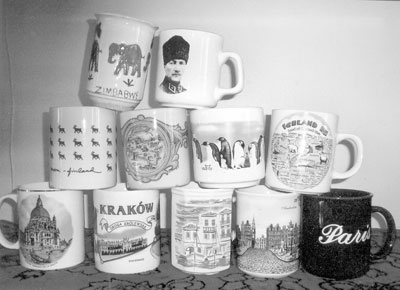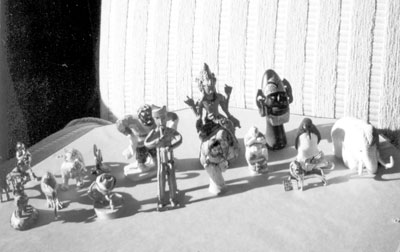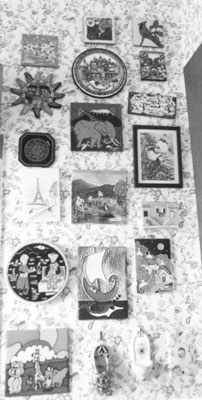Memorabilia
What do YOU collect on trips overseas? That’s what we asked readers to write in about. We printed some of the responses in last month’s issue, and here are a few more. Have something to add? Write to Memorabilia, c/o ITN, 2116 28th St., Sacramento, CA 95818, or e-mail editor@intltravelnews.com (please include your surface-mail address).
(Second of two parts, go to part one)
It all started 20 years ago in London when I bought my first miniature porcelain buildings as gifts. They were replicas of actual houses: Jane Austen’s, Dr. Johnson’s London house, an oast barn and so on. The gifts didn’t get given, and those buildings became the foundation of a 2,000-plus collection.
Every trip means additions to the collection, although they also come from catalogs, antique shops and junk shops, as gifts and, these days, from Ebay. The search for buildings enlivens every trip and lends purpose to my shopping expeditions.
A couple of years ago on a “Caves and Cathedrals” tour across northern Spain, I managed never to go inside a cathedral (seen one cathedral, seen them all, at least on that trip!). The group would go inside while I raced around the souvenir shops buying small cathedrals set inside Santiago shells as well as horreos (the raised farm buildings for storing grain, specific to Asturias).
For me, the most desirable buildings are those truly souvenir buildings that are made of metal. For reference, think Statue of Liberty, Empire State Building and Notre Dame. The manufacture of souvenir metal buildings more or less ended some years ago and they were replaced by buildings made of composite materials, but recently the metal buildings have begun to be manufactured again (in Spain and the Netherlands especially). They are frequently of pewter but also of the standard pot metal finished in brass or silver.
One of my most valued treasures is an “Angkor” made for the 1931 Exposition Coloniale Paris that I bargained for at an outdoor Paris antique show (I in English and the dealer in French). It’s rare and valuable. I paid $100 in 1996, and one just went for nearly $900 on Ebay! I know it’s insane, but the same could be said of the 300 or 400 people who make up the Souvenir Building Collectors Society in the U.S.
My recent trip to Turkey netted only half a dozen buildings, all of some sort of clay or composite material, but last year’s trip to Norway brought a fabulous carved wooden stave church.
Each trip is different, and each building is different. Collecting them is fun and meaningful, especially when I bring home replicas of the very buildings I visited.
Patricia S. Smith
Brooklyn, NY
After 40 years of travel, had we brought back a souvenir from each country, our home would be full of useless “stuff.” However, so that we have a small reminder of every place we’ve been, we collect a representative miniature house or building from each destination.
Since most are less than three inches high, they pack easily inside a shoe or a corner of the luggage. The country and the year are identified in permanent ink on the bottom of each.
Our whole collection fits on one living room shelf. We call the collection our International Village.
Joan L. Welch
Indiana, PA
Thought I’d mention some items that have attracted my “pack rat” tendencies while traveling throughout the world since ’77: matchbooks (several hundred from all over the world), beer coasters (two or three hundred from all over the world) and KLM delft houses (about 35 or 40 business-class “giveaways”).
Before the airlines converted all the baggage tags to a standard bar-coded format, I collected tags from most domestic airlines for destinations within the U.S. plus those of many international carriers. They are very colorful, and I’ve had several decoupage mounted for a wall display. I still have quite a number of them.
Allen Jones
Memphis, TN
I collect pillow covers and have very close to 100 of them. The pillow covers usually have the name of the country we traveled in.
Sometimes, if I can’t find one (e.g., in Tasmania), I will buy a towel, put a backing on it and sew it up. In Cuba I bought two small, lace table covers and sewed them together.
Margaret Hoge
San Jose, CA
I collect rare, unusual or different seeds (flower or vegetable), cooking recipes (from individuals or restaurant/hotel chefs) and cookbooks plus exotic spices. Not all these items are collected in each country, but I try as the occasion arises.
For instance, on a 2003 Central America tour I collected cashew nuts and, from Guatemala, black-corn kernels (a rarity in the U.S.). Now a cashew tree is growing from planting the nut. I was given four kernels of the corn, and when I planted them at home they grew into four cornstalks eight to 10 feet tall and produced 10 ears. I kept some kernels for future plantings and ground the rest into cornmeal to make tasty, dark tortillas.
I’m a volunteer cook for a charitable organization and I am always on the lookout for unusual recipes.
Helen Edmondson
Carmichael, CA
In the late ’70s I was going to the Orient on a business trip and was seated in my favorite seat, the single one in the nose of the top deck of a Pan Am 747. After a delicious meal, the stewardess served me coffee accompanied by an attractive silver spoon. She saw me admiring the spoon and suggested that I take it with me, saying something like, “You paid for it in the ticket price.”
That started my collecting silver spoons from airlines over the next decade until I retired in 1986. I accumulated spoons from about 25 airlines, some now long since out of business. Each of the spoons is distinctive and different.
I have rarely flown first class in my retirement, and I hope that the airlines have not switched to plastic in their cost-cutting efforts.
How do you spell “kleptomania”?
Thomas C. Miller
Lehigh Valley, PA
We sometimes visit grocery stores in other countries to see the unusual items being sold. One day in an oriental market in Honolulu we saw a pair of unusual bowls. We purchased them and enjoyed them so much that we began to collect pairs of bowls from other places.
We have bowls from Óbidos, Portugal; Carcassonne, France; Isola Bella, Italy; the Stanley Market in Hong Kong, and several other places. They come in many sizes and we use them for cereal, soup, ice cream, etc. We make them a part of our daily life and thoroughly enjoy them.
Dr. Homer & Marilynn Brown
Norman, OK
My mug collection enables me to relive my adventure of choice every morning over breakfast. My guests are always intrigued to be able to choose a special country for their coffee.
Mugs are inexpensive, easy to pack and always useful.
The only disadvantage is that they are not available in some parts of the world. Thus my collection lacks Bhutan, Nepal, Thailand, Xi’an in China, Papua New Guinea and Easter Island. In a few years I’m sure they will catch on to this tourist favorite and I will (happily) have to go again!
Marilyn Lutzker
Sunnyside, NY
We pick up refrigerator magnets from all the places we visit. We try to limit ourselves to only one from each town or significant place.
The worst one we have is of the Matterhorn. For such a great and wonderful place, it had a rinky-dink magnet.
Bill Goss
Los Altos, CA
We collect alabaster and try to find a piece wherever we travel. Flea markets in London, Vienna and one near Bacharach, Germany, have produced treasures. We shipped an alabaster lamp home from Holland. In Pisa, Italy, we found an entire store of alabaster.
In 1986 we saw several heavy pieces in a Liechtenstein shop and couldn’t decide if we wanted to carry one home. A green bowl was marked, “Fr188, now one-half off for Fr94.” We left and came back later and the shopkeeper said we could have it for Fr70. It’s one of our favorites.
Rhodes, Majorca and other islands have added to our collection of over 200 pieces.
John & Marilyn Scofield
Sequim, WA
I collect miniature dollhouses and accessories (one-inch-to-one-foot scale). I seek out dollhouse shops and local artisans. Also, I look in the shops for small items: key chains, magnets or anything of a one-inch scale.
Certainly, this does not require much space in my luggage and it is less expensive than purchasing full-size items for my house.
I have an abundance of miniature treasures from around the globe, including a globe. I put stamps in miniature picture frames.
In Hobart, I was invited into the home of the president of the miniature dollhouse club in Tasmania. I bought from her some miniature boomerangs, postcards of Tasmania and a kangaroo puzzle. What a find!
Marcia Henderson
North Las Vegas, NV
About 25 years ago my wife and I began international travel for business, with side trips for vacations. I began collecting small figurines (one to four inches high), which I termed “Little People.”
In my collection of 100 from 26 countries, the most memorable were acquired in Siberia, India and Indonesia.
John L. Fox
New York, NY
In over 70 years of traveling the seven continents (and the geographic North Pole), I have collected a wide assortment of small treasures. The collections include mice, angels, stuffed animals and various other items, including a camel whip, an elephant prod, a bolo, a cannibal fork, a seal-skinning knife, a blowgun and a Yemenese knife.
This whole collecting thing began with a gilded burlap angel purchased at a folk art exhibit in Barcelona many years ago. The mouse collection came about when a friend gave me a knitted “house mouse” with the admonition that “every house should have a mouse.” I also have over 50 small boxes, made of everything from straw to silver.
I can’t begin to tell you how much pleasure we have derived from the hunt and the displays. My husband and I both enjoyed poking around in shops. Searching for a suitable souvenir for our personal collections took us into some very interesting shops and situations. I am almost 90 and still traveling and still shopping.
Muriel Dowe
Fort Worth, TX
We have traveled extensively over the past 30 years, and I have been attracted to the variety of boxes I found in every country visited. I made no conscious effort to “collect,” but as time passed I realized this interest had naturally evolved and a collection had resulted.
The group from Southeast Asia includes boxes of delicate bamboo strips woven into decorative patterns; woven bamboo with hand-carved wood inserts, and wood with 3-dimensional scenes showcased in the lids, not to mention small wooden ones with lids embellished with salt flowers and others with hand-painted lacquer or silver filigree.
Among the others are Russian hand-painted lacquer boxes; Spanish gold work from Toledo; small, hand-carved replicas of Swaziland beehive huts; a wooden, clamshell-shaped box with wooden hinge from Guatemala; brass boxes from Casablanca; a hand-painted camel bone box from Turkey, and a brass betel nut box from Indonesia.
There is no end to the variety to be found. These items are unique examples of handicraft, and their purchase directly helps the local artisans. They are easy to pack and carry and can be easily displayed.
Whenever I look at them, I remember the place and occasion of each purchase and thus keep the memories of wonderful experiences alive.
Shirley Whitehead
Granite Bay, CA
My Unitarian faith has led me to see the spiritual wisdom that comes from all cultures and belief systems. Therefore, I collect god/goddess figures from around the world.
On my little altar can be found Aboriginal dreamtime figures, Egyptian deities, African symbols and the Infant of Prague, among others. I also have collected Roman and Greek gods, Chinese figures and characters important to Hindu mythology. Most recently I brought home a Mayan corn god from Guatemala and a black Jesus from Panama.
My favorite, a jade Buddha figure from Thailand, holds a place of honor on my altar.
Looking at all the figures together gives me a great sense of peace. I guess it’s knowing that people from all times and all places have looked outward to find something bigger and more wondrous than human existence allows for.
We also collect some little Christmas-tree-hangable thing from each country we visit. Since these bits of memorabilia come out only once a year, it keeps our home from filling up with souvenirs.
Bonnie M. Lee
Summerfield, FL
Our bathroom wall is hung with tiles my husband, Carl, and I have collected on our many trips. We started with one tile and now we do a diligent search in each country to find the tile that is “just right” to depict that country.
We have a tile in the shape of a slipper from Morocco, a simple hand-painted tile of Dubrovnik, a tile of a pensione in Italy, a hand-painted tile of animals from South Africa, etc.
Our display brings back many wonderful memories of our trips abroad, and we have a great time looking for the “just right” tile.
Lorna Tjaden
New Hope, MN
Thirty years ago, when I started traveling the world extensively, I decided I needed to start a collection. I was shopping in Barcelona, Spain, in a store that had beautiful picture tiles of Don Quixote’s journeys. My collection began with four of those colorful tiles.
Not only have I enjoyed collecting more than 300 tiles over the years, but it has become an excellent way of enhancing the decor of my home, and it’s a conversation piece when people come to visit for the first time. It also gives me a reason to shop on my journeys.
I have no trouble finding tiles in every city. I find some in souvenir stores and others in out-of-the-way antique areas.
They range from very inexpensive to very expensive, depending on the artist and the manufacturer. I usually choose according to what attracts my attention, but in some antique stores I have found series of anywhere from six to 12 tiles with a theme to them.
For example, in London I came across some antique Minton tiles in black and gold depicting many of Shakespeare’s plays. On another U.K. trip it was King Arthur’s adventures done in blue and black. In Hawaii I was able to get a series of traditional pictures painted on tiles, all done in brown tones. In Holland I bought a series of 12 blue-and-white Delft tiles, each depicting a month of the year and what happens there during that month regarding crop harvests and traditions. All of these series of tiles were my most expensive, ranging from $150 to $500 for each collection of six to 12 tiles.
However, most of my other tiles I bought one at a time in every European, Asian, African, Middle Eastern and North and South American country you can think of, and prices ranged from $5 to $50, with most going for about $20. On the back of each tile I identify the location and year of travel.
Usually, a scene of the area is pictured — landscapes or unique houses. A few even depict historical events. I stay away from floral tiles.
Most are 6-inch tiles, but a few are 4-inch and others are 8-inch. Most are flat, but some are three-dimentional. They hang on many walls of my home in groups of about 50, adding much color and uniqueness to the decor.
It gives me such pleasure when I look at them (and that is often). A big smile crosses my lips when I think of the fun time I had at a particular destination and how lucky I am to have such wonderful memories of my travels.
Sandy Fox
Scottsdale, AZ



